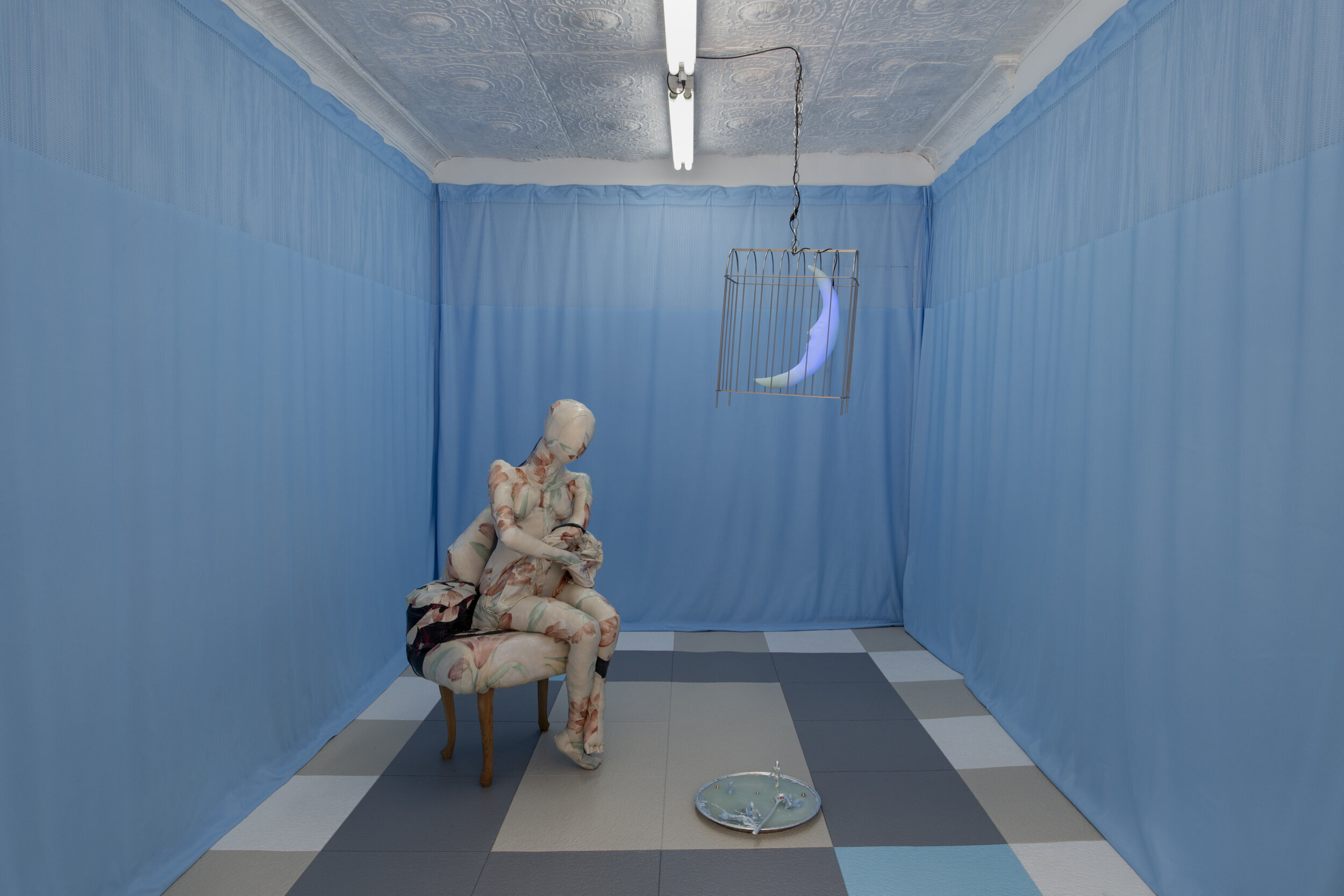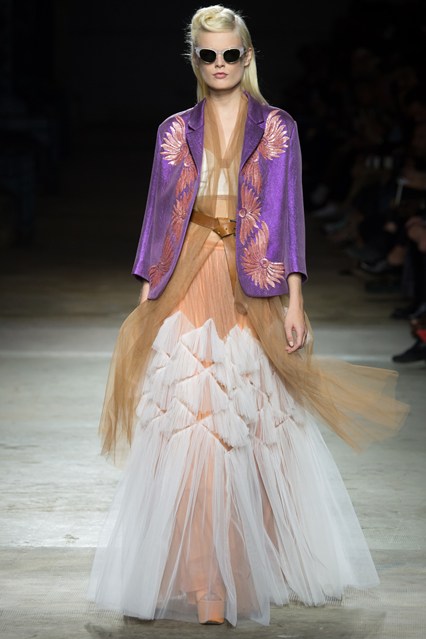text by Adam Lehrer
Artist Cristine Brache has developed an interest in surrealism. For her recent exhibition, Commit Me, Commit to Me (Cázame, Cásame) at New York’s Fierman Gallery, the artist has created a sculptural installation rife with references to some of the surrealist movement’s most important female practitioners. In particular, the anthropomorphic forms and hybridity between body and object of the figurative sculpture that functions as the installation’s centerpiece, Woman Getting Reupholstered, recalls those soft sculptures of Dorothea Tanning such as Nue Couchée, 1969. The larger installation—in which a figure appears seated with the floral pattern emblazoned on both the piece of furniture and the figure indistinguishable, a resin moon illuminated by a striking shade of blue, entitled Gaslight (After Remedios Varo, Papila Estelar, 1958), is hanging from the ceiling concealed within a small bird cage, and a kind of miniature mountain replete with water depicts small figures bathing and swimming—references Mexican surrealist Remedios Varo’s 1958 painting Papila Estelar. Brache had previously only been familiar with the male surrealists, and the renewed interest in the work of the women within the movement—Carrington, Varo, Leonor Fini, Dorothea Tanning, and others—that has developed in efforts to correct its canon made Brache understand why people had told her in the past that her work evoked surrealism.
“When I saw [these artists’] work I found myself drawn to surrealism for the first time,” says Brache. “I was drawn to surrealism because it’s a code. Lately, I’ve been drawn to the ways in which oppressed groups speak in code to survive or avoid persecution for self-expression.” As an example of cultural codification, Brache often points towards the Orishas, or the spirits/deities of the African Yoruba diaspora who identities were merged into those of the Catholic saints to survive the onslaught of erasure that came with the Caribbean slave trade. “Due to the need to assimilate with the icons of Catholicism , the deities were assigned a correlating Catholic Saint,” she says. “The survivalist mutations of Santeria that draped Yoruba beliefs in a cloak of Christian beliefs is known as syncretization.” Her exhibition last year at Locust’s Projects in Miami, Cristine’s Secret Garden, explored this notion in depth. Ghosts, like ideas and concepts, are adaptable.
Woman Getting Reupholstered, 2020
Fabric, foam, oak, hardware Approximately
55 x 30 x 22” (140 x 76 x 56 cm)
Brache believes that that codified language of surrealism—and as Roland Barthes pointed out in Death of an Author—is an especially codified language because it sought to unleash the potential of the unconscious mind via the “irrational juxtaposition of images” that help separate a work or text from its maker or author—is especially suited to women artists. She cites an article written by Lexi Mantakis for Dazed. “Women emblazoned surrealism with a new type of self-awareness never achieved by their male counterparts,” writes Mantakis. “Their intuitive expression turned the movement from something quite dissociated with reality, to a deeply personal exploration of human emotion, personal trauma, the subconscious, female sexuality, and identity, all through a lens of fantasy.”
Breton saw surrealism as a movement that liberated artists to explore and express “the actual functioning of thought.” To Brache and Mantakis, male artists used surrealism to project their interiorities and fantasy lives onto the world, while female artists used the codified fantastical imagery and language of surrealism to express something more rooted in lived reality. Surrealism gave women artists the opportunity to express themselves in a veiled way that allotted a kind of freedom, and were able to do this better than their male counterparts because women are used to being culturally conditioned to codify communication. “All marginalized groups find ways to codify their behavior to survive or avoid persecution,” says Brache. “Women often use (for example) beauty and demeanor/language as tool to operate within patriarchal systems (take women's use of exclamation points in emails). To me, this is a code.”
Brache sees surrealism as contradictory in its treatment of the women in its canon. From her perspective, the history of the movement has been typified by one persistent gaslight, or manipulation by means of denying reality, in which the artists who best exemplified its tropes have until very recently been relegated to the status of muse to some of surrealism’s most famous male artists. Tanning, for instance, was better remembered as Max Ernst’s wife than she was a significant artist in her own right until relatively recently. Photographer Dora Maar had long been historicized as one of Picasso’s muses, rather than one of surrealist photography’s foremost pioneers. Do women actually make for better surrealists? It’s hard to know, really, whether an artistic style can be better realized according to the genders of its practitioners. But nevertheless, Brache’s approach in her recent exhibition forces her audience to confront questions around gender, art history, manipulation, and cultural codification. For Brache, surrealism is emblematic of the oppressed artist screaming to be heard while self-conscious of who might actually be listening.
Bathers’ Soup, 2020
Baroque freshwater pearls, resin, stainless steel, genuine silver leaf, birch, polymer clay
16 x 18 x 4” (41 x 46 x 10 cm)
That Brache hadn’t quite understood her connection to surrealism is interesting, because manifestations of the style in her work have always been rather clear. On the surface level, one could make the connection between Brache’s working in a variety of disciplines and the multivariate practices of her surrealist forebears. Like Carrington, whose fantastical and bizarre short stories rivaled her visual artworks in their importance, or Unica Zurn, who produced writings that pioneered the “abstract horror” style that would later influence writers like Clarice Lispector and Blake Butler at the same time that she was producing macabre and strangely seductive illustrations and drawings, Brache is as serious about her work in text—poetry, specifically—as she is in her visual artwork. “It's totally a different process, but I think the feelings and intentions come from the same place,” says Brache. “I like different media because it does different things and it can enhance an idea as a result of its very form.”
But perhaps more indicative of Brache’s connections to surrealism is her underlying artistic ethos. The artist excavates her own psychology and personal experiences, and connects it to broader collective struggle. The work isn’t about her necessarily, but nevertheless her own memories and traumas inform the ways in which she makes art about the world around her. The personal, the political, and the social collide and coagulate in the work, blurring the structural boundaries between self and group “I draw from my personal experience and use that to look to the world in order to articulate a collective experience to bring awareness and empower people (on a personal level),” says Brache. “I would never want to make work about something I haven't experienced myself because I don't think it's my place to.” Her 2018 painting, Painting of a Collage My Mother Made (she cut Michelle Pfeiffer’s face out so she could be catwoman), recreates a collage made by her mother in which her mother’s face replaces the actress in the second Tim Burton Batman film. The image becomes a tender homage to a mother while it also emphasizes a woman’s desire to be creatively fulfilled, empowered, demanding to be heard and seen.
Gaslight (after Remedios Varo, Papilla Estelar, 1958), 2020
Resin, steel, LEDs, electrical wire
24 x 20 x 11” (61 x 51 x 28 cm) - sculpture size, installation dimensions variable based on chain length
Partially, one of the reasons that surrealism remains seductive to contemporary viewers is its direct, libidinal simplicity: the clarity in the paintings of René Magritte, the frank and explicit sexuality in Louis Aragon’s novels, the freedom in the automatist approach to art making. Surrealism utilizes simplicity to transport content and ideas directly into its viewers’ subconscious minds. Like the vampire priest in Park Chan Wook’s Thirst who reanimates his dead lover with sex and the offering of his own blood, surrealism allows the artist to share his/her world with a viewer through blunt, erotic, and sometimes violent imagery. The content is codified, but the concept communicated is often clear. Directness, or simplicity, characterizes Brache’s work as well, and she concedes that directness is something that she strives for, but makes sure to differentiate it from ‘flatness.’ “If you can communicate something complex simply, then I believe you've distilled the idea to its purest form,” says Brache. “There’s nothing around the idea that gets in the way of its interpretation.”
You see this directness in her poetry, its blunt provocations and incisive observations of sex, womanhood and contemporary life in liquid modernity. In her poem Sophie, the text reads like something you’d read off of some lurid dating profile.
my name is Sofia, black eyes, with a tight and petite body, I am 168cm,49kg, 35c-24-34. a cute and sexy girl. I work in a cloth shop in daytime, but in nighttime I am also doing some part time escort.
In Brache’s video piece made in collaboration with the artist Brad Phillips, ppants (for Brad), Brache is depicted in lower profile and over the course of two minutes she slowly urinates in her own jeans. A pee spot grows in width over her crotch while the flash of a camera is seen going off behind the frame. The elemental transgression of taboo becomes both playful and heroic; the decision to lose control over bodily functions becomes an act of power. One can imagine the ghost of Henry Miller watching from behind the camera, muttering “I love everything that flows.”
Surrealism has long been the spectre haunting Brache’s work, but in Commit Me, Commit to Me (Cázame, Cásame) the spectre has become corporeal. She is now dealing with the legacy of the movement as she has always dealt with art making: directly. Brache is placing herself within the legacy of surrealism, and seeing within it a style specifically suited to be made by women who have already adapted to codify their language within the oppressive hierarchies of contemporary life. Surrealism is an art of “code-switching.” Brache is an artist interested in codes.
Commit Me, Commit to Me (Cázame, Cásame) was intended to be on view from February 22nd - March 29th, 2020 before its run was cut short by the Coronavirus pandemic. For more information, contact Fierman Gallery in New York and follow @cristinebrache_ on instagram.




















